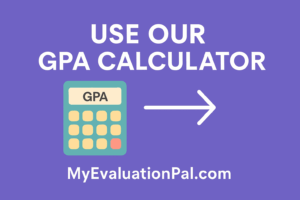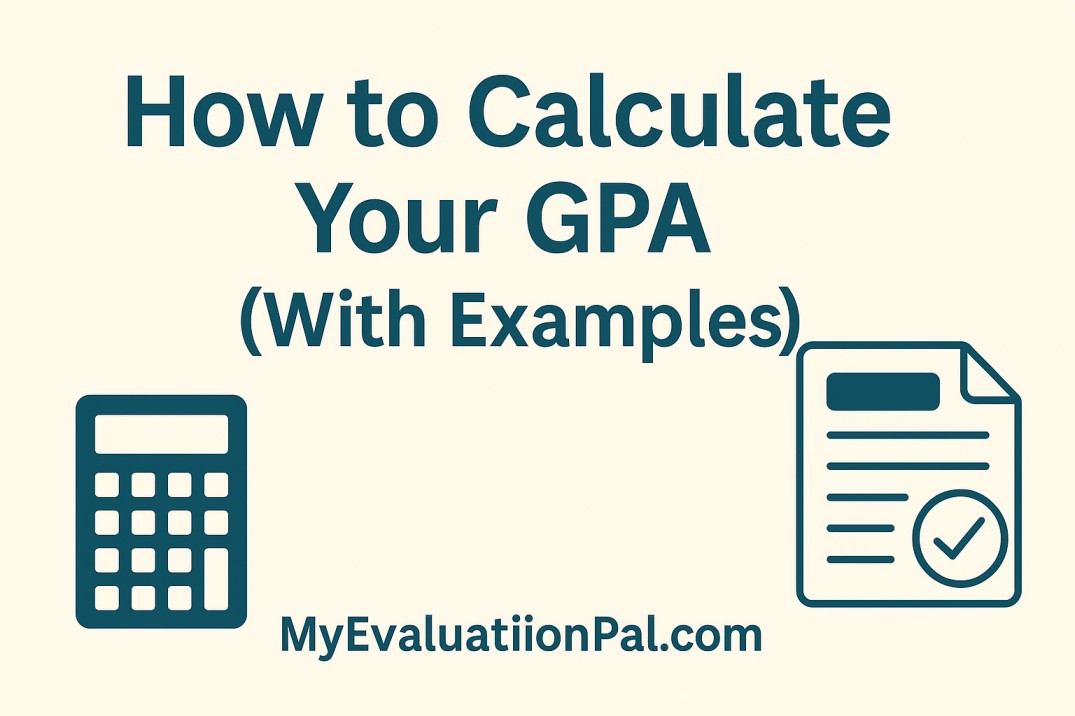If you’re a student trying to figure out where you stand academically—or aiming to reach a specific GPA for scholarships, college admissions, or personal goals—understanding how to calculate your GPA is essential. Whether you’re in high school or college, knowing how your grades convert into your Grade Point Average (GPA) helps you track progress, set realistic goals, and improve your academic standing. In this complete guide, we’ll walk you through the step-by-step process of calculating GPA manually, show you real-life GPA calculation examples, explain the difference between weighted and unweighted GPA, and share tips on how to boost your score. You can also save time by using our free online GPA calculator tool at MyEvaluationPal — perfect for students who want quick, accurate results without doing the math themselves.
✅ Want to skip the math? Use the free GPA calculator on MyEvaluationPal to get your GPA instantly!
What is a GPA?
GPA is a standardized method used by schools and colleges to measure a student’s academic performance over time. It provides a numerical summary of your grades by converting letter grades (such as A, B, C, etc.) into grade points, which are then averaged across your courses. Most institutions in the United States use a 4.0 GPA scale, where an A equals 4.0, a B equals 3.0, and so on. Your GPA gives colleges, scholarship committees, and potential employers a quick overview of how well you’re doing academically. Whether you’re in high school, college, or applying to graduate programs, understanding your GPA is key to setting goals, maintaining eligibility for financial aid, and meeting academic requirements. For students aiming to improve their grades or track their progress, using a reliable GPA calculator can make this process easier and more accurate.
Here’s the general scale used by most U.S. schools:
|
Letter Grade |
Quality Point |
|---|---|
|
A |
4.0 |
|
B |
3.0 |
|
C |
2.0 |
|
D |
1.0 |
|
F |
0.0 |
Some schools use plus/minus variations (like B+ = 3.3), and others use weighted scales for honors or AP classes.
Step-by-Step: How to Calculate Your GPA
Let’s go through how to calculate your GPA manually:
🔹 Step 1: Convert Letter Grades to Grade Points
Convert each class grade into its numerical equivalent using your school’s GPA scale.
🔹 Step 2: Multiply by Credit Hours
For each class, multiply the grade point by the number of credit hours the class is worth.
🔹 Step 3: Add Total Grade Points and Total Credit Hours
Sum up all the grade points and all the credit hours.
🔹 Step 4: Divide Total Grade Points by Total Credit Hours
GPA = Total Grade Points / Total Credit Hours

📊 GPA Calculation Example
Let’s say your grades and credit hours for a semester look like this:
|
Course |
Grade |
Credit Hours |
Quality Point |
Total Quality Points |
|---|---|---|---|---|
|
Math |
A |
3 |
4.0 |
12.0 |
|
English |
B |
3 |
3.0 |
9.0 |
|
History |
C |
2 |
2.0 |
4.0 |
|
Science |
B |
3 |
3.0 |
9.0 |
|
Total |
— |
11 |
— |
34.0 |
GPA = 34.0 / 11 = 3.09
📌 You can also plug in your own courses and grades into the MyEvaluationPal GPA Calculator for quick results.
Weighted vs. Unweighted GPA
Unweighted GPA is on a 4.0 scale, regardless of class difficulty.
Weighted GPA gives extra points for honors or AP classes (e.g., A in an AP class = 5.0).
Some schools use a 5.0 or even 6.0 scale for weighted GPA. Always check your school’s grading policy.
Why GPA Matters
•🎓 College Admissions – Most universities use GPA as a core factor in evaluating your application.
•💰 Scholarships – Many scholarships have minimum GPA requirements.
•📈 Academic Standing – Your GPA determines if you’re eligible for honor rolls or in danger of probation.
Need help planning your grades for success? We’re creating a free GPA Planning Toolkit — stay tuned!
Frequently Asked Questions (FAQs)
❓ What’s a good GPA?
A GPA of 3.5 or higher is typically considered very good, though this can vary by school or program.
❓ Can I raise my GPA fast?
Improving your GPA takes time and consistent effort. Focus on doing well in upcoming classes and retaking lower-graded courses if allowed.
❓ Do all schools use the same GPA scale?
No. Some schools use weighted scales, others don’t. Some use A+ as 4.3, while others cap it at 4.0.
Knowing how to calculate your GPA gives you a powerful tool to track and improve your academic performance. Whether you’re applying to colleges or just trying to meet a personal goal, understanding this system helps you stay on course.
🎯 Start tracking your grades today with the GPA Calculator on MyEvaluationPal — it’s simple, fast, and free.

Leave a Reply